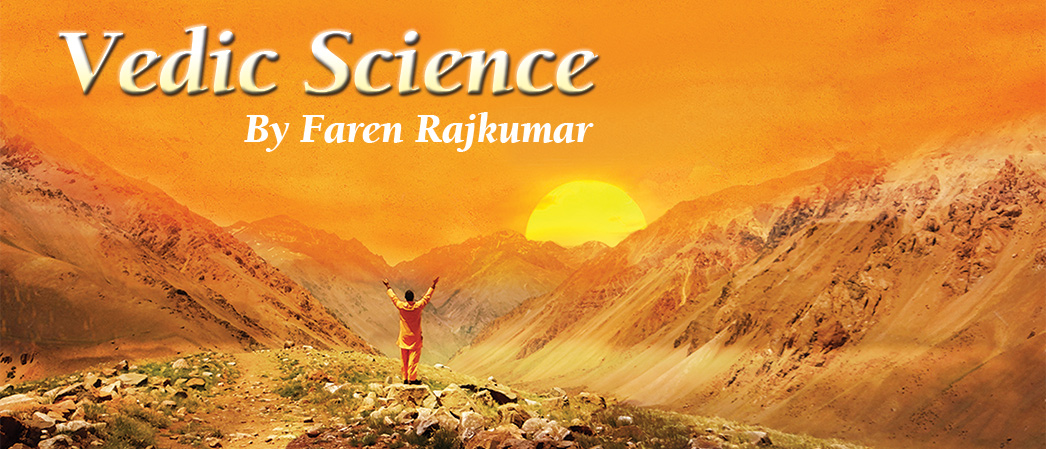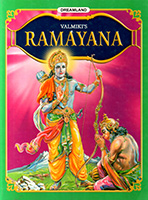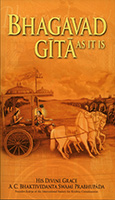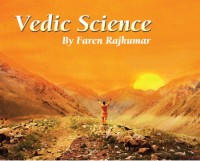Vedic Science
Author by Faren Rajkumar

The most ancient of all religions has found itself thrust into the middle of a modern sphere that differs so dramatically from the days of ancient India. Hinduism is free from the worldly confines of a date of origin, setting it far apart from so many other religions that are able to boast proud relevance in modern history because of their precise timelines of creation. Therefore, Hinduism’s seemingly distant relation to contemporary practitioners is understandable; today’s younger generation in particular, a group of people so affected by radical technological and social change, seeks a way of life that can connect them to the Earth, its seven billion people and its beautiful past and future. Without knowing for certain from where our morals and principles originated, it is natural that some of us young Hindus feel less than enamored with the teachings of Vedic Dharma. But with some simple effort and a minor shift in perspective, the philosophies and principles of Vedic Dharma can be adapted and woven seamlessly into the fabric of our contemporary lives.
Our religion is not a stagnant one that can only be appreciated by the wise sages residing in the Himalayas – Vedic Dharma, having been extracted from the unseen reaches of the cosmos, encompasses all aspects of life, from familial duties to the very definition of one’s role in society. Our scriptures speak of a divine energy source from which we were all created, Brahma. We are tiny, precious fragments of glittering crystal broken from a single, perfect stone. We are these little bits of bright energy that yearn to reunite in Moksha, growing closer to and more worthy of liberation with every passing lifetime. Hinduism is the mere collection of a great body of knowledge that guides us through the physical world of illusion and back towards our truest, most divine form. It gives us hope to see past the trials and tribulations of everyday life. It gives us restored faith in humanity as we recognize the God within even those who hurt us. Most importantly, it gives us happiness accompanied by the knowledge that someday we will achieve divine bliss. Most of the laws that govern the modern democratic world, such as the United State’s Constitution, are famously revered as “of the people, by the people and for the people”. Similarly, Vedic Dharma, being without a human creator, is “of the Universe, by the Universe, and for the Universe.” Thus, it can never be regarded as anything less than the most sensible and natural approach to achieving spiritual success, for people of any generation. It contains so many flexible means of addressing every aspect of life that can appeal to even the most doubtful of young devotees. Even though the tumultuous present day differs greatly from the days of ancient India, the knowledge of Vedic Dharma will always continue to make an impact upon the ever-changing world, and it is by placing emphasis on the aspects of our religion that contain the most modern appeal that we can ensure endless Hindu faith among the younger generation.
Before outsiders invaded ancient India and forcefully imposed upon us their own religions and social hierarchies, all Hindus embodied the essence of Vedic Dharma in their daily lives. It is these same daily practices that should be placed at the forefront of modern temple services and education programs to reinstate the practice of Hinduism as it was originally intended to be; a way of life, and not a mere Sunday morning ritual. Hindus rose daily to greet the rising sun with yoga and the Surya Namaskar, humbling themselves before the glory of nature and uniting their bodies and minds in good health. They nourished their bodies with only Sattvic foods, or foods free of any animal products that might degrade one’s well-being and harm the Earth. Meditation also provided them with clarity of mind in preparation of the day’s challenges, and singing and dancing in the name of God inspired devotion and faith. All of these practices have been scientifically proven to maintain and even improve one’s physical and mental health, which is why they also happen to be integral parts of of the global “Green” movement that has gained popularity in recent years. This modern movement towards Earth consciousness, promoted by hipsters and tree-huggers around the world, borrows countless ideas from Hinduism and revamps them so that they appear to be novel ways to care for the planet or one’s body. However, the now popular practices of vegetarianism, yoga and meditation are merely simple, ancient ways of nourishing one’s body that can, and should, be used as a means to gaining a deeper understanding of spirituality and closeness to God. Young Hindus should be taught the true value of these practices by their parents and their spiritual leaders, because they will create tangible results that the generation of instant gratification craves, and will inevitably lead to a deeper respect for themselves, the Earth and God.
be; a way of life, and not a mere Sunday morning ritual. Hindus rose daily to greet the rising sun with yoga and the Surya Namaskar, humbling themselves before the glory of nature and uniting their bodies and minds in good health. They nourished their bodies with only Sattvic foods, or foods free of any animal products that might degrade one’s well-being and harm the Earth. Meditation also provided them with clarity of mind in preparation of the day’s challenges, and singing and dancing in the name of God inspired devotion and faith. All of these practices have been scientifically proven to maintain and even improve one’s physical and mental health, which is why they also happen to be integral parts of of the global “Green” movement that has gained popularity in recent years. This modern movement towards Earth consciousness, promoted by hipsters and tree-huggers around the world, borrows countless ideas from Hinduism and revamps them so that they appear to be novel ways to care for the planet or one’s body. However, the now popular practices of vegetarianism, yoga and meditation are merely simple, ancient ways of nourishing one’s body that can, and should, be used as a means to gaining a deeper understanding of spirituality and closeness to God. Young Hindus should be taught the true value of these practices by their parents and their spiritual leaders, because they will create tangible results that the generation of instant gratification craves, and will inevitably lead to a deeper respect for themselves, the Earth and God.
 Yoga, for example, is more than a form of physical fitness for those who truly understand the practice. It is an intrinsic part of Hinduism, a daily reverence to the divine within. Each asana, or pose, is merely a single limb of the essential eight associated with yoga. These limbs encompass all of the physical and mental attributes of the practice, and severing one from the rest leaves the yogi disabled. Every movement of every asana must be synchronized with one’s breath and thoughts, enveloping the body and mind in a complete, spiritual experience. Much of the Western world, including its young people, is focused on the single limb of the physical pose, thus depriving the largest population of yoga practitioners of the full benefits. Undoubtedly, there are benefits to be reaped from yoga that are purely physical, but the practice is diminished when the asanas are taken out of context. Although the Western world sometimes acknowledges yoga’s ancient Hindu roots, it has also been accepted by many that associating the word “Hindu” with yoga gives the practice too much unwelc
Yoga, for example, is more than a form of physical fitness for those who truly understand the practice. It is an intrinsic part of Hinduism, a daily reverence to the divine within. Each asana, or pose, is merely a single limb of the essential eight associated with yoga. These limbs encompass all of the physical and mental attributes of the practice, and severing one from the rest leaves the yogi disabled. Every movement of every asana must be synchronized with one’s breath and thoughts, enveloping the body and mind in a complete, spiritual experience. Much of the Western world, including its young people, is focused on the single limb of the physical pose, thus depriving the largest population of yoga practitioners of the full benefits. Undoubtedly, there are benefits to be reaped from yoga that are purely physical, but the practice is diminished when the asanas are taken out of context. Although the Western world sometimes acknowledges yoga’s ancient Hindu roots, it has also been accepted by many that associating the word “Hindu” with yoga gives the practice too much unwelc ome baggage. The depiction of Hinduism in the minds of Westerners is uncharacteristically colorful, near-savage and eccentric. Young Hindus today are subjected to this incorrect version of Hinduism in their schools, and thus adopt the same stigma. Yoga has a completely divergent portrayal. It is viewed as a peaceful act, associated with the vibrations of “Aum” and the gentle sound of the ocean, therefore, many people cannot make the connection between yoga and Hinduism. But in reality, our traditions are indeed colorful, but are painted with mantras and the belief that God is the supreme, manifested across the universe in infinite ways. Yoga is a means of spiritual attainment for all who seek it, and the young generation would gain much from an increase in yoga education and practice. The union of the mind and body is a grandiose concept for a youthful intellect to comprehend, but it can be adapted to fit into daily life through yoga. Yoga classes for the young members of the temple can be held before or after Sunday services. Allowing the children and teenagers to take charge of the class and demonstrate the asanas for one another will provide a sense of empowerment and pride in the practice, and they will encourage one another to use yoga as a daily means of attaining good physical and mental health. Yoga will eventually become a natural part of our morning routines, bringing all young Hindus closer to spiritual union with God. Yoga is typically followed by meditation, which is another aspect of Hinduism that has gained popularity in the Western World since the 1960s and the movement of Transcendental Meditation led by Maharishi Mahesh Yogi. Famous individuals like The Beatles increased the appeal of meditation tenfold, and people of all religions, ages and nations began learning to chant and free their minds. Young Hindus can be educated in the practice of mediation once they are made aware that it is a scientifically proven and time-tested method of creating mental clarity and union with God. By also teaching youths of the impact that mediation has had on the Western world, just like yoga, they will feel encouraged to adopt the practice without hesitation. They will understand that if even non-Hindus can find such peace and success in mediation, then they do not have to fear that they might be spending their time chanting in vain. The will persevere through the often challenging process, with the regular guidance of their spiritual leaders and encouragement of their peers, until they achieve an unforgettable experience of spiritual bliss.
ome baggage. The depiction of Hinduism in the minds of Westerners is uncharacteristically colorful, near-savage and eccentric. Young Hindus today are subjected to this incorrect version of Hinduism in their schools, and thus adopt the same stigma. Yoga has a completely divergent portrayal. It is viewed as a peaceful act, associated with the vibrations of “Aum” and the gentle sound of the ocean, therefore, many people cannot make the connection between yoga and Hinduism. But in reality, our traditions are indeed colorful, but are painted with mantras and the belief that God is the supreme, manifested across the universe in infinite ways. Yoga is a means of spiritual attainment for all who seek it, and the young generation would gain much from an increase in yoga education and practice. The union of the mind and body is a grandiose concept for a youthful intellect to comprehend, but it can be adapted to fit into daily life through yoga. Yoga classes for the young members of the temple can be held before or after Sunday services. Allowing the children and teenagers to take charge of the class and demonstrate the asanas for one another will provide a sense of empowerment and pride in the practice, and they will encourage one another to use yoga as a daily means of attaining good physical and mental health. Yoga will eventually become a natural part of our morning routines, bringing all young Hindus closer to spiritual union with God. Yoga is typically followed by meditation, which is another aspect of Hinduism that has gained popularity in the Western World since the 1960s and the movement of Transcendental Meditation led by Maharishi Mahesh Yogi. Famous individuals like The Beatles increased the appeal of meditation tenfold, and people of all religions, ages and nations began learning to chant and free their minds. Young Hindus can be educated in the practice of mediation once they are made aware that it is a scientifically proven and time-tested method of creating mental clarity and union with God. By also teaching youths of the impact that mediation has had on the Western world, just like yoga, they will feel encouraged to adopt the practice without hesitation. They will understand that if even non-Hindus can find such peace and success in mediation, then they do not have to fear that they might be spending their time chanting in vain. The will persevere through the often challenging process, with the regular guidance of their spiritual leaders and encouragement of their peers, until they achieve an unforgettable experience of spiritual bliss.
Similarly, vegetarianism is another practice that should be more heavily emphasized in Hindu communities, as it is the only way to provide nourishment for one’s body while staying true to the Vedic principle of ahimsa, or nonviolence. The violent sacrifice of an animal for a moment of carnal satisfaction so viciously assaults the Hindu principle that all life is divine and sacred. The divine elements, earth (bhumi), fire (agni), air (vaayu), water (jala), and sky (akasha), are integral parts of daily Hindu worship, therefore, the oceans, forests, animals, and planets are also worthy of daily worship. The damage that our own environment has sustained at the hands of the carelessly consuming global population is shameful, and it defies the poignant Hindu principle of respect for the Earth. The idea that the animals we choose to keep as pets or admire in a zoo are no different from the animals we might choose to consume should be upheld in everyday life. Young people should be taught, by the example of their elders, spiritual leaders and peers, that vegetarianism is the simplest way to adapt the honorable principle of respecting the divine in all forms of life. The modern influence of popular culture, combined with the ease of access to unhealthy and unholy foods, encourages young people to consume meat. But those with more a significant influence upon a child’s life, such as their parents or older siblings, possess the power to ingrain in them the strong belief that one does not need to harm other life forms in order to provide for themselves. By declaring that they are a vegetarian from a young age, a Hindu will indirectly promote the very idea of ahimsa and spread the word of omnipresent divinity. They will gain a higher respect for the Earth and its precious resources, which is the original intention of vegetarianism, but will do so through the simple and seemingly effortless means of refusing to eat meat. Adherents to the modern Green movement have already recognized the positive effects of vegetarianism; they have adapted this beautiful Hindu ideal to their lives and young Hindus should be eager to do the same. Those who defy the norms of the masses are viewed as unique, and members today’s young generation are constantly seeking ways to stand out. They will likely not hesitate to adopt vegetarianism if it is presented to them with the core moral of respect at the forefront.
Also in line with the desire to be unique, young people seek hobbies that will set them apart from their peers. But we need not look further than our own beautiful Vedic culture and religion, because music and dance are integral aspects of Hindu devotion that can fulfill two purposes in young person’s life. Firstly, these art forms can provide them with an admirable talent that they can use to proudly depict their way of life and its history to the rest of the world. Secondly, and more importantly, they can create a relevant method of learning to dedicate one’s actions selflessly to God. Many Hindu youths are hesitant to engage in the pure bhakti, or devotional, aspect of Hinduism and refrain from attending pujas, yagnas and other rituals. Language barriers and a lack of understanding of the often complicated symbolism of Hindu rituals can understandably prevent youths from connecting with devotional worship. But being able to dedicate a part of one’s life to God is an act of humility that can be derived from more than just temple rituals. The concept of devotion can be adapted into daily life as youths are taught to play musical instruments, train their voices or study various traditional dance forms, such as Bharatanatyam or Kuchipudi. They can use these skills to vocalize songs about God’s glory and beauty, or dance to the words of a story from the Ramayana, Bhagavad Gita and other scriptures. Temples should offer these classes for its young members, taught by skilled elders in the community or professionals willing to volunteer their time, or even assist the youth in organizing Kirtan groups with weekly rehearsals and regular performances. As their skills improve and they share their talents, the artists’ families and friends will inevitably provide as much encouragement and supports as they do in the realm of academic achievement. A young Hindus will be filled with a sense of accomplishment and humility as a performer when they dedicate their actions to a supreme source much greater than themself. The most beautiful way to perform worship is in a manner that brings the devotee bliss, and young people are known for their keen interest in and passion for artistic expression. It will feel natural for a person already so enamored with their instrument or dance form to practice and perform as a oblation to God.
Young Hindus seemed to have strayed from temple halls in recent years, especially those who are second or third generation Americans with sparse ties to the motherland of India. We are caught in a whirlwind of technological innovations, aggressive popular culture influences and the encroaching ideas promoted so blatantly by majority religions. But we should not be afraid to adhere to the specific aspects of our religion that allow us to maintain a deep relationship with God in practical and appealing ways. Yoga, vegetarianism, meditation and Indian art forms should be highly encouraged within the Hindu community and taught to children from the day they are old enough to learn. The modern Green movement has already given these practices a place in popular culture, so in an age in which young people struggle to conform and meet social pressures, they can confidently express their religious identity without fear of judgment, ridicule or estrangement. They, and even their non-Hindu friends, can proudly adapt these practices into their daily lives, and as they inevitably become healthier and happier individuals, they will also become inadvertent advocates of Vedic Dharma. But most importantly, they will feel the physical and spiritual benefits of the ancient traditions they have applied to their lives, and will begin to crave a deeper, more holistic experience. The greatest of all spiritual journeys begins simply with the sincere adherence to a few practices, which will lead to the desire for a greater understanding of the wealth of knowledge outlined by the most ancient and profound way of life in the universe.
 About the Author
About the Author
Faren Rajkumar is a senior English Honors student at Nova Southeastern University, where she is also an editor at The Current newspaper and Digressions literary magazine. Faren recently completed a writing program at the City University of New York’s Graduate School of Journalism, and is pursuing a career in writing. Her essays and articles on Hinduism have appeared in numerous publications, including The Huffington Post and Hinduism Today. She has been a long time volunteer in the Hindu community and with the Hindu American Foundation, and completed the Bala Vihar program at South Florida Hindu temple.




























Leave a Reply
You must be logged in to post a comment.